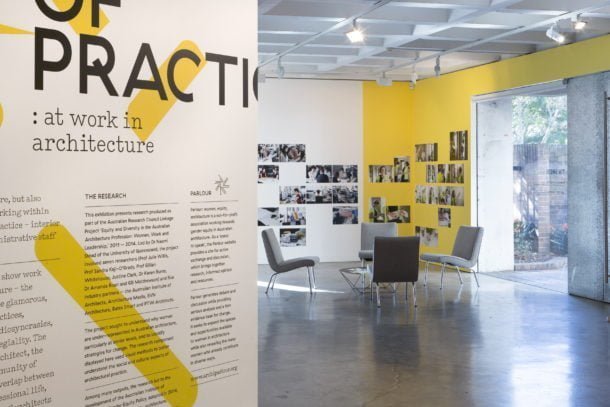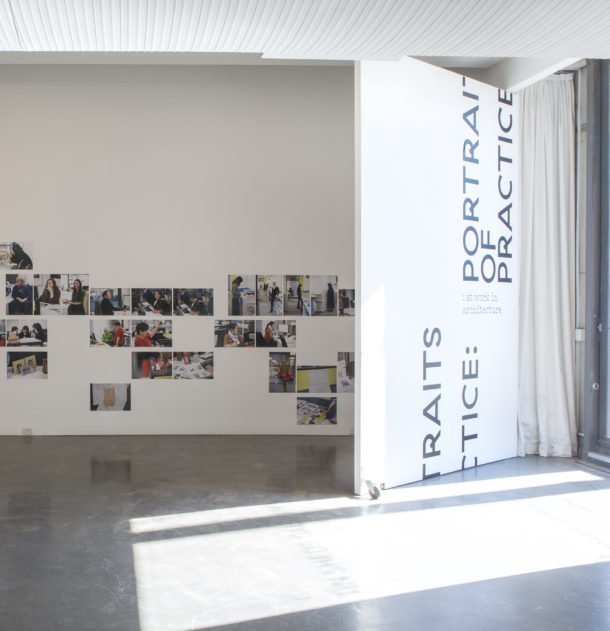History does not document contributions evenly. Janine Campbell reflects on the structural conditions of her own erasure, and Parlour’s role in this.

Photo: Jessica Maurer, courtesy of Faculty of Architecture, Design and Planning, University of Sydney.
History is made not by those who have achieved or innovated, but by those who choose to acknowledge and document these events and moments.
In July 2015, Parlour curated the exhibition Portraits of Practice, which sought to portray “a visual archaeology” through photographs taken in three architectural office, while also “increasing the visibility of women architects and their achievements within architecture.”
This was exhibited at the Tin Sheds Gallery, within the Faculty of Architecture at the University of Sydney. Initiated in the 1970s, with the support of Australian Prime Minister Gough Whitlam, the gallery was housed in freestanding temporary shed until it was relocated to the refurbished Wilkinson Building in 2004. The gallery has pioneered exhibitions of both Australian and international architects, artists, practitioners and academics.
Portraits of Practice succeeded in presenting a visual archaeology of women in contemporary practice. This is important because one of the barriers women architects face is being written out of history; their contributions overlooked, not acknowledged at all. Contributing to this invisibility is that fact that one’s ‘architecture’ belongs forever to the office that employs you – usually to the directors who own the company – whether they worked on or contributed to the project at all. And, despite the exhibition’s intentions of increasing visibility, Portraits of Practice failed to acknowledge the architect who contributed to creating the gallery space, thereby highlighting the exact issue the exhibition was aiming to eliminate.
That architect is me.
While working at Bates Smart, I led this project alongside architects Priscilla Williams and Alan Lamb – my role included preparing the brief and interviewing the curators/custodians (Jan Fieldsend and Phil Granger), developing the concept, conducting the tender and doing the contract admin. One important architectural feature of the original gallery was the City Road billboard. Although the new gallery was in a smaller space, my idea to continue this billboard opportunity, showing the artwork on the street, was developed into the large sliding illuminated facade door that is part of the current design.

Photo: Jessica Maurer, courtesy of Faculty of Architecture, Design and Planning, University of Sydney.
This goes to the question of raising one’s hand for acknowledgement – and why many women architects have not done this. It also relates to the topic of large practices that publish books and media (history making) that only referring to the male partners of that firm, reinforcing the impression, reiterated throughout history, that only men design buildings and spaces.
I write this tacitly believing I am not supposed to tell anyone I led this project, but I remind myself that it is just insane to pretend that I did not.
When I raised this oversight with Parlour, Justine (one of the curators) responded in humble and intelligent way, and can offer a way to navigate such things in the future (this is only just the beginning of lifting the lid on an altered architectural history). In the past I have raised some oversights and double standards in the practices I have worked at. At times this has been met with intense and sometimes aggressive backlash, answering the question of why some women architects have remained silent.
Janine Campbell worked for 15 years in Sydney for several large architectural practices and for 5 years in Zurich, Switzerland both as an artist and architect. She is Vice President of the Australian Institute of Architects International Chapter and founder of Atelier 604, a design practice that has emerged from a breathtaking alpine beauty and antipodean friendliness.




















